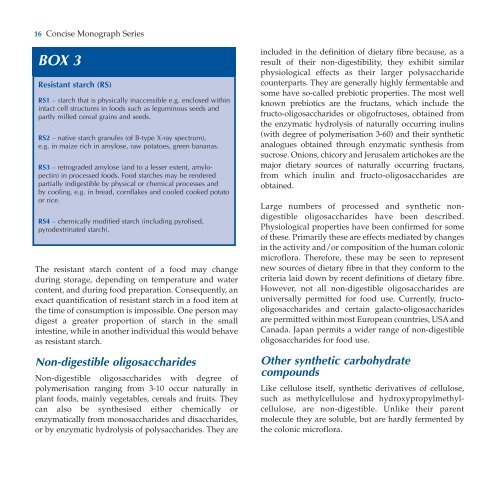Dietary Fibre - ILSI Argentina
Dietary Fibre - ILSI Argentina
Dietary Fibre - ILSI Argentina
Create successful ePaper yourself
Turn your PDF publications into a flip-book with our unique Google optimized e-Paper software.
16 Concise Monograph Series<br />
BOX 3<br />
Resistant starch (RS)<br />
RS1 – starch that is physically inaccessible e.g. enclosed within<br />
intact cell structures in foods such as leguminous seeds and<br />
partly milled cereal grains and seeds.<br />
RS2 – native starch granules (of B-type X-ray spectrum),<br />
e.g. in maize rich in amylose, raw potatoes, green bananas.<br />
RS3 – retrograded amylose (and to a lesser extent, amylopectin)<br />
in processed foods. Food starches may be rendered<br />
partially indigestible by physical or chemical processes and<br />
by cooling, e.g. in bread, cornflakes and cooled cooked potato<br />
or rice.<br />
RS4 – chemically modified starch (including pyrolised,<br />
pyrodextrinated starch).<br />
The resistant starch content of a food may change<br />
during storage, depending on temperature and water<br />
content, and during food preparation. Consequently, an<br />
exact quantification of resistant starch in a food item at<br />
the time of consumption is impossible. One person may<br />
digest a greater proportion of starch in the small<br />
intestine, while in another individual this would behave<br />
as resistant starch.<br />
Non-digestible oligosaccharides<br />
Non-digestible oligosaccharides with degree of<br />
polymerisation ranging from 3-10 occur naturally in<br />
plant foods, mainly vegetables, cereals and fruits. They<br />
can also be synthesised either chemically or<br />
enzymatically from monosaccharides and disaccharides,<br />
or by enzymatic hydrolysis of polysaccharides. They are<br />
included in the definition of dietary fibre because, as a<br />
result of their non-digestibility, they exhibit similar<br />
physiological effects as their larger polysaccharide<br />
counterparts. They are generally highly fermentable and<br />
some have so-called prebiotic properties. The most well<br />
known prebiotics are the fructans, which include the<br />
fructo-oligosaccharides or oligofructoses, obtained from<br />
the enzymatic hydrolysis of naturally occurring inulins<br />
(with degree of polymerisation 3-60) and their synthetic<br />
analogues obtained through enzymatic synthesis from<br />
sucrose. Onions, chicory and Jerusalem artichokes are the<br />
major dietary sources of naturally occurring fructans,<br />
from which inulin and fructo-oligosaccharides are<br />
obtained.<br />
Large numbers of processed and synthetic nondigestible<br />
oligosaccharides have been described.<br />
Physiological properties have been confirmed for some<br />
of these. Primarily these are effects mediated by changes<br />
in the activity and/or composition of the human colonic<br />
microflora. Therefore, these may be seen to represent<br />
new sources of dietary fibre in that they conform to the<br />
criteria laid down by recent definitions of dietary fibre.<br />
However, not all non-digestible oligosaccharides are<br />
universally permitted for food use. Currently, fructooligosaccharides<br />
and certain galacto-oligosaccharides<br />
are permitted within most European countries, USA and<br />
Canada. Japan permits a wider range of non-digestible<br />
oligosaccharides for food use.<br />
Other synthetic carbohydrate<br />
compounds<br />
Like cellulose itself, synthetic derivatives of cellulose,<br />
such as methylcellulose and hydroxypropylmethylcellulose,<br />
are non-digestible. Unlike their parent<br />
molecule they are soluble, but are hardly fermented by<br />
the colonic microflora.

















